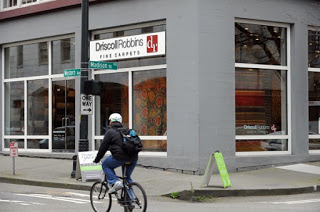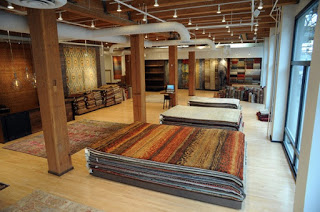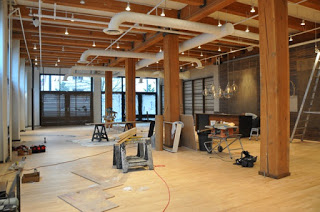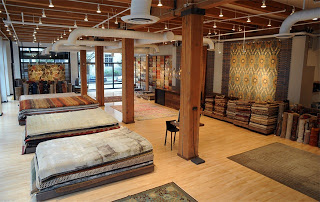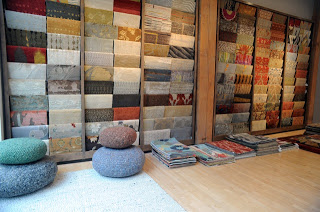I was once disparagingly told by a sales representative (Company A) whom we will presume was feeling some heat from above, that a new to the scene rug company (Company L) was targeting all of the very same dealers of Company A. To quote(ish): “It’s pretty obvious they just looked at our dealer list (which was publicly available on their website I will add) and are targeting our dealers.” I greeted this statement with a level of indifference appropriate to the situation: complete. Targeting your competitor is far from new and trying to fault Company L just seems juvenile and whiney. It’s almost as though said representative was going on saying “It’s not fair….” – a phrase that makes me want to vomit – but I digress. While it is true Company A did all of the research and cultivation they held no legal/proprietary/mystical claim to a list of dealers, and besides, as I’ve said before, the list of great carpet and rug dealers (even as it is ever evolving) is finite, and thusly it would be inevitable that if Company A and Company L both made superior quality carpets, they would naturally gravitate toward the same great rug and carpet dealers. That is to say that in the end they would have ended up in the same place regardless of their methodology. To me, it is simply the natural order of things.
Furthermore I will postulate it is also quite easy to know, that is to say “know of” the people behind the names we respect, admire, and relentlessly pursue in hopes that they too will carry our line(s) of beautiful handmade carpets. Sure you can argue it is easy to know who is behind “Carol Piper Rugs” because her name is on the door, but if I say “floordesign” or “Aubrey Angelo” I am willing to bet you all know who is behind those companies as well. My point, if there is one, is that we know of them, but don’t really know them. So, in an effort to change that I present something completely different for “The Ruggist”: An interview with the well regarded Driscoll Robbins as he gives us his thoughts on the rug industry and a peek into his recently moved and expanded eponymous Seattle showroom.
The Ruggist (TR): I first learned of you and your showroom when I was researching my job pitch to Lapchi. And then of course when I worked for them your reptation as an outstanding dealer preceded our eventual meeting. Throughout the eight (8) or so years that have passed since that time, I don’t think I’ve even heard the story of how you started. Would you care to enlighten us?
Driscoll Robbins (DR): I opened my showroom in 1997. Before that I worked for James Opie in Portland for 2 years, and before that with Woven Legends in Philadelphia for another 2 years. Although my parents were respected antique carpet dealers in San Francisco, I never paid much attention to rugs until after I graduated college and needed a job. Somehow I managed to convince Woven Legends I knew something about rugs (which I didn’t). My time at Woven Legends and James Opie gave me the background and confidence to move up to Seattle and open my own showroom. My timing couldn’t have been better as Seattle was booming with technology companies and little competition in the area of contemporary handwoven rugs. I opened my doors with very little money which today would be nearly impossible.
TR: Obviously you’ve enjoyed success in Seattle; Who are your clients? Trade-Only? Retail?
DR: It depends on the month but the majority of our business is to the trade. I’ve always been happy not to rely strictly on retail or trade. It’s a fine line to walk but so far we’ve been successful at having a retail presence without alienating the designer.
TR: I consider you to be part of the “new generation” (read into that what you will) of rug dealers, partly because of your age, but also because of your approach to rugs. What do you do that you think really sets your showroom apart from others? From that, what advice would you offer to others?
DR: My dad gave me some important advice early in my career about sticking to the high-end and never try to be all things to all people. I buy beautiful rugs regardless of price. Wealthy consumers demand the best and are willing to pay for it in both good economies and bad. My aesthetic has always tended toward simple contemporary. Even our traditional carpets have a modern, updated look. For the past 15 years I’ve seen a trend away from the classic oriental carpet to a more refined modern look. In addition, we have become experts in the custom business. Custom has been the single most important part of our business over the years.
TR: Custom is important to you and arguably the entire high-end rug industry… What are the features and benefits you and your clients look for in a custom rug?
DR: Most importantly we need to have confidence in the producer. The worst thing is to have a custom rug come in wrong after waiting six (6) months. I tend to avoid doing custom in Pakistan or Afghanistan because you never know what might show up. After years of ordering custom rugs, we know what various suppliers are capable of and we can guide our clients to the line that best suits their needs.
TR: Getting back to “buying beautiful rugs regardless of price.” Can you elaborate on that?
DR: I’ve been amazed how certain rugs just don’t sell no matter the price. When we have our annual sale I mark certain old rugs below our cost. At the end of the sale those rugs never sell. It’s always the newest, choicest pieces that sell even though they are priced much higher. Buying a rug because it’s inexpensive is the biggest mistake a dealer can make.
TR: And what “makes” a really choice rug as it were?
DR: It’s not easy to describe what makes a beautiful rug. It’s an emotional reaction. My brain sets off happy chemicals that tell me to “buy that rug”. I think it has something to do with the balance of colour, texture and artistic merit.
TR: Since you mentioned your annual sale this might be a great time to start talking about your recent move and what motivated that. How about the burning, $64,000.00(USD) question: Did you have a big traditional “moving sale”? You know the kind: SAVE 70%-99.9999995%. Everything must go! No reasonable offer refused. Owner’s Reserve, all that kind of crap that the industry is (unfortunately) reviled and ridiculed for.
DR: I considered having a sale but decided against. We only have one sale a year and it’s in the fall. If we have more than one sale a year it cheapens our business model and it upsets our interior designer clientele. I was also too busy with the move to think about having a sale.
TR: Oh I remember being so busy the one time I moved a rug store, after a week of ten (10) hour days moving countless rugs I just came home from work, sat on my bed and woke up three (3) hours later. Ahh… the good olde days. I guess that means you’ve completed the move into the new showroom; tell me more about your new space and what your goals are for the new location.
Exterior View of the new Driscoll Robbins Showroom.
(One wonders if Seattle pays cyclists to be in every photo.)
Interior View of the new Driscoll Robbins Showroom.
DR: We are moving from 2,700 sq/ft to 4,500 sq/ft. Although it’s literally across the street from our old location, the space is bigger, the light is better, and we now have huge street presence. I love creating new environments and it’s been a dream of mine to design the ideal carpet showroom. I was also motivated by the fact you can never get too complacent in this business otherwise your competition will pass you by. I wanted to make a statement that we are the premiere Seattle dealer for high-end handwoven rugs.
Before – Interior View of the new Driscoll Robbins Showroom.
After – Interior View of the new Driscoll Robbins Showroom.
TR: So with almost twice the space of your old showroom are you planning on adding more lines?
DR: It’s amazing how a large space allows you to better show off the inventory you already have. By opening up the space and creating more surface area, it appears we have double the inventory. It also allows us to better display lines that got lost in the recesses of our old showroom. We developed a hanging wall display on sliding tracks to showcase new lines including hide rugs, shag rugs, etc. We also designed display shelves with attached seating to feature textile pillows. This will be the first time we’ve ever sold anything other then handwoven rugs but I’ve always thought beautiful pillows accent rugs nicely.
Corner Sample Display Wall and comfy looking floor cushions!
TR: What features of the new showroom do you think are going to offer the biggest benefit to your clients?
DR: We are offering three (3) customer parking spaces behind the showroom. We are in downtown Seattle so parking has always been a huge problem for us. We want to make it easy for clients to drop by without getting a parking ticket. We also designed extensive corner sample and rug displays so customers can do more self browsing.
TR: It is interesting to hear you say that parking is one of your biggest features. As a seasoned suburban rug dealer I never really considered this in my younger days, but have come to appreciate how the small $8.00 (USD) savings to the designer adds immeasurable convenience and removes an impediment that might otherwise keep them away or shopping elsewhere. Speaking of which, how do you “keep” clients from shopping elsewhere? Exclusive lines and or territories?
DR: Exclusivity in lines has become a thing of the past. Wholesalers are willing to sell to most anyone as long as they pay their bills. As a retailer, it’s important for us to offer the best buying experience and offer the greatest selection to the consumer. It’s also important to private label rugs as much as possible. If a company’s name and design are too accessible it makes it easy for them to shop on the internet. I’ve also started designing my own line of rugs which are unique in the marketplace. We’ve had an amazing response to our new line.
TR: I feel like I should tease you by saying “Oh, so now you fancy yourself a rug designer?” because this has been a trend amongst not only the top percentile rug showrooms, but also for the industry in general for sometime (though obviously some more successful than others…). What are some other trends you’d care to forecast? Where do you think the industry is headed next?
DR: I don’t have a crystal ball but my gut tells me there will be fewer handwoven rug suppliers and retailers in the future. As the cost of weaving continues to climb producers will be squeezed out of the business or forced to find other alternatives. There will always be high end consumers willing to pay for top quality handknotted rugs but inevitably there will be fewer retailers. On the bright side, innovation will continue and beautiful rugs will continue to be made.
TR: If you’ll allow me a little indulgence, I find the cost of weaving to be a major concern and agree with you that it will have long term negative effects on the industry. Take (because I love to belabour things) the example of crossed vs. uncrossed weaving. The pricing structure is now such that in order to make crossed woven carpets a company is now forced to pay what I consider a punitive price compared to uncrossed. Innovative to keep costs down for sure, but to what end? Like all things though I guess it comes down to: Does it matter to you or your customer?
DR: It really doesn’t matter to me if the foundation is crossed or uncrossed and it certainly doesn’t matter to my customers.
TR: Sadly I am in full agreement with you that it doesn’t matter to customers. But one thing that does matter is padding. What do you recommend?
DR: We use Durahold for 90% of our pad needs. We’ve experimented with other pads but always come back to Durahold. We’ve had problems with other pads off gassing our drying out too quickly.
TR: Rhetorically, I assume if I were to turn back a carpet in your home I’d find that padding? Speaking of which, what is one rug you have at home right now? Did you get to pick it or did the family have a say?
DR: I have a large orange “grass” rug from Michaelian & Kohlberg in my family room because those rugs are incredibly durable and easy to clean. I have two (2) small boys and they can really mess up a room. In my living room I just custom ordered a Tamarian rug. I’ve had it about a week and it really pulls the room together. I bring rugs home and my wife has veto power.
TR: It seems spouses always have veto power even though we’re the experts, no? Hmmm don’t answer that, I don’t need to be in any more trouble today. Speaking of things that get me in trouble, how about one last question? You mentioned “grass” and as it is we’ve reached the end and not really had anything irreverent, which, lets be frank, is part of the reason people read “The Ruggist”. So with that….Would you care to share any thoughts on opinions on the recent legalization of marijuana in Washington State? Can we expect to see a “lounge” at DR any time soon? (you don’t have to answer if you don’t want to…)
DR: I’m all for the legalization of marijuana. Our new pillow/lounge display may get some use after all. Thanks for the idea.
Ladies and Gentlemen: Driscoll Robbins, innovative indeed.
Thank you and goodbye.
Full(ish) Disclosure: Though it may appear as though I was paid to promote Driscoll Robbins, I was not, nor did I receive any compensation. Furthermore I, nor Red Spruce, have an existing business relationship with Mr. Robbins. However, if you want to pay me…., or if Mr. Robbins would like to carry Red Spruce…. the phone lines are currently open. I kid, but not, but sort of…

